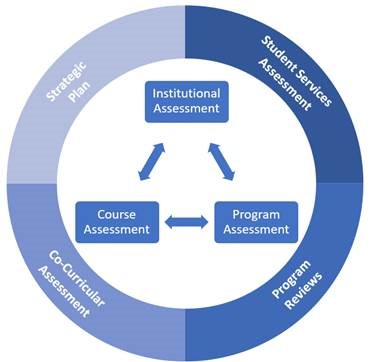Assessment of student academic achievement is linked closely to and directly supports the mission of Phillips Community College.
Our Mission
The Mission of PCCUA emphasizes a commitment to helping every student succeed. The College provides high-quality, accessible educational opportunities and skills development to promote life-long learning and engages in the lives of our students and our communities.
What is Assessment?
Assessment is the ongoing process of establishing clear, measurable, expected outcomes of student learning; systematically gathering, analyzing, and interpreting evidence to determine how well performance matches those expectations and using the resulting information to understand and improve student learning throughout the College.
Assessment promotes quality across the institution by providing evidence to guide effective decision-making regarding institutional changes, programmatic changes, and classroom teaching modifications.
Three key purposes of assessment:
Our Mission
The Mission of PCCUA emphasizes a commitment to helping every student succeed. The College provides high-quality, accessible educational opportunities and skills development to promote life-long learning and engages in the lives of our students and our communities.

What is Assessment?
Assessment is the ongoing process of establishing clear, measurable, expected outcomes of student learning; systematically gathering, analyzing, and interpreting evidence to determine how well performance matches those expectations and using the resulting information to understand and improve student learning throughout the College.
Assessment promotes quality across the institution by providing evidence to guide effective decision-making regarding institutional changes, programmatic changes, and classroom teaching modifications.
Three key purposes of assessment:
- To Inform - Assessment activities show a clearer picture of what is really happening in a program and inform others of program contributions.
- To Improve - This evaluation is formative. Assessment activities provide a feedback loop to help shape or form better programs and services.
- To Prove - This evaluation is summative. Assessment activities provide evidence to sum up what a program is accomplishing and provide persuasive indicators to students, faculty, staff, and the community.
Assessment Outcomes
Institutional Assessment
Division of Arts and Sciences
Criminal Justice
Division of Allied Health and Nursing
Division of Applied Technology
CDL/Truck Driving
General Technology
Welding
Division of Business and Information Systems
Key Performance Indicators (KPIs)
Institutional Changes Resulting from Assessment
- Identification and prioritizing of assessment goals
- Adapting the referral form so that it is used in a more comprehensive way
- Examination of the current advising system
- Establishing an Assessment webpage for publishing assessment outcomes, information, and resources
- Publication of division and institutional assessment outcomes
- Increased interdivisional communication and cooperation to achieve assessment and other goals
- Examination and modification of documents used to identify learning outcomes
- Clarification of divisional roles in assessment
- Increased knowledge of divisional and student service responsibilities toward student assessment
- Greater desire by faculty and administrators to gauge student learning outcomes and use data to make decisions contributing toward better instruction
- Cooperative effort of divisions within the College and an appreciation for each division's role in assessment
Annual Assessment Results
Co-Curricular Assessment